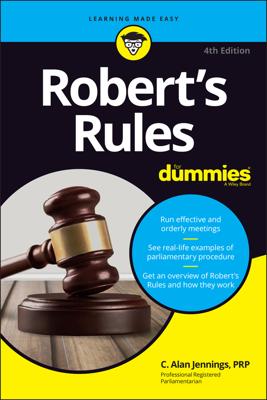Using the motion to Rescind or to Amend Something Previously Adopted, you can undo or change any decision your group made in the past. Nothing is forever, and that saying is especially true in the world of clubs and organizations. Last year’s good idea can turn into this year’s problem. But thanks to General Robert’s wisdom and foresight, you always have a way out!
The motion to Rescind (or repeal or annul) is used to cancel a motion altogether.
The motion to Amend Something Previously Adopted is used to make a change to a motion either by making a simple change or two or by substituting something else in its place.
Motions to Rescind or to Amend Something Previously Adopted are more common than you may think. More often than not, they’re used to make policy changes. After all, policy is adopted by motion and vote, so if you want to change the policy or vacate it, you need to do so by motion and vote. When using the motions to Rescind or Amend, keep these points in mind:
The vote required, which is determined by whether there has been previous notice of the motion
Whether any proposed amendments are within the scope of your notice
A motion to Rescind or to Amend Something Previously Adopted
Can’t interrupt a speaker who has the floor.
Must be seconded.
Is debatable.
Can be amended. If the proposed amendment is to change the motion to rescind to one of amend something previously adopted (or vice versa), you must propose the change by offering a primary amendment to substitute the preferred form for the other.
Requires a two-thirds vote without notice, a majority vote with notice, or a majority of the entire membership with no notice.
Can be reconsidered if it fails.
Vote requirements
Three possible variations of vote requirements allow you to rescind or amend something previously adopted:
Two-thirds vote without previous notice: Suppose your organization adopts a budget proposed by the finance committee, which provided for an increase in the salary of your executive director. Then later, when new business is being considered, Ernest Pennypincher proposes to roll back all spending to last year’s budget amounts. Because this motion would have the effect of rescinding the budget just adopted, it requires a two-thirds vote.
Majority vote with previous notice: But what if, instead of making the motion during this meeting, Ernie just gives notice that he will make the motion at the next meeting? Well, when the motion comes up at that later meeting, it can be adopted by a majority vote.
The switch from a two-thirds to a majority vote may make a big difference because it could be easier to get a majority vote than to get a two-thirds vote. The equalizer is the requirement for notice. Because both sides of an issue have the chance to rally their troops and campaign for the result they want, the factor of previous notice reduces the requirement for a two-thirds vote.
Majority of the entire membership: In a situation in which there’s no notice, a motion to Rescind or to Amend Something Previously Adopted can be adopted if it receives the affirmative vote of a majority of the entire membership.
You may be thinking that receiving this type of vote is an impossible requirement anyway, so what good is this last option? After all, you’ve probably never even had a majority of the entire membership attend a single meeting at the same time anyway. But consider the option’s application in a small board.
Suppose that you have a board of 15 members, and 13 are present at your meeting. If all 13 vote, a two-thirds vote requires 9 votes, but a majority of the entire membership is only 8. So sometimes it’s easier to achieve a majority of the entire membership than it is to get a two-thirds vote.
In a committee, you can rescind or amend a committee decision by a majority vote if all the members who voted in favor of the motion to be rescinded or amended are present or received adequate notice. Otherwise, the two-thirds vote requirement applies to the vote to rescind or amend committee action.
What motions you can’t rescind or amend
Some motions can’t be amended or rescinded:
Motions subject to the motion to Reconsider: Calling to rescind or amend is unnecessary if you can simply call up the motion to Reconsider, which has been previously moved.
Motions that have already been carried out and that cannot be undone: If you voted to repaint the church, it’s too late to rescind the motion after the church has been repainted.
Motions that have been adopted to accept resignations or actions electing or expelling a person from membership or office (if the member is present or has been notified): After a resignation has been accepted or a membership terminated by expulsion, the resigning or expelled person can be reinstated only by following the procedures for membership admission or election to office.
Rescinding an election requires either a provision in the bylaws or specific procedures for removal from office.

